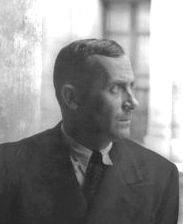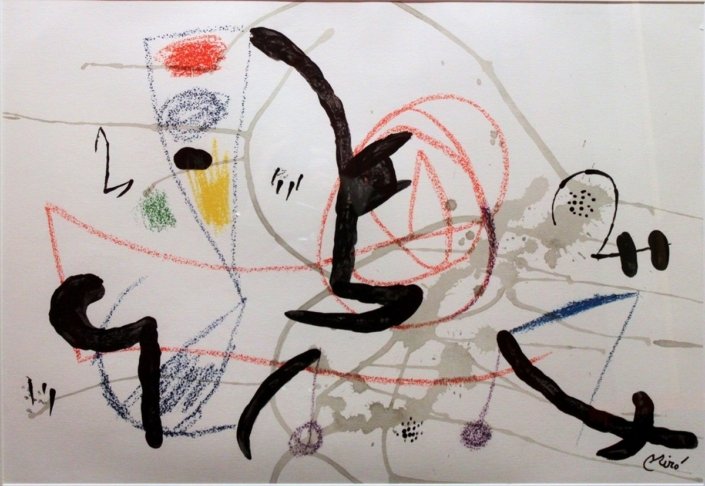Joan Miró (Barcelona 1893 – Palma de Mallorca 1983)
Miró werkte als schilder, beeldhouwer, graficus, keramist.
Hij begon in 1912 een kunstopleiding in Barcelona en vanaf 1920 volgde hij lessen aan de Académie de la Grande Chaumière in Parijs. Hij heeft gewerkt in onder andere Barcelona, Parijs en op Mallorca.
Miró is een van de belangrijkste surrealistische kunstenaars. In Parijs raakte hij bevriend met onder meer Pablo Picasso, Max Ernst, Hans Arp en René Magritte. Miró werd beïnvloed door het kubisme, maar heeft nooit een volledige abstractie doorgezet. De vormen in zijn werk blijven altijd refereren aan een realiteit – die van de werkelijke wereld of die van dromen. In 1925 ontmoette C de grondlegger van het surrealisme, André Breton. Die zag hem als de grootste surrealist, hoewel Miró zich nooit formeel bij het surrealisme heeft aangesloten. Miró staat bekend om zijn bio-morfische schilderkunst, waarin een poëtische droomwereld de setting is waarin objecten loskomen van hun functie. Zo integreren ze in een organische figurenwereld, die wordt bepaald door de vrouw, de natuur en seksuele problematiek.
Exposities en Prijzen
In 1954 ontving Miró de prijs voor grafische kunst op de Biënnale van Venetië, in 1958 ontving hij de Guggenheim International Award. In 1979 kreeg hij de hoogste onderscheiding van de Catalaanse regering, de Medalla d’Or de la Generalitat. In Spanje zijn twee musea geheel gewijd aan Miró. Zijn werk is daarnaast opgenomen in vele belangrijke museale collecties.
Miró worked as a painter, sculptor, graphic artist, ceramist.
He began an art education in Barcelona in 1912 and from 1920 he took lessons at the Académie de la Grande Chaumière in Paris. He worked in Barcelona, Paris and Mallorca, among other places.
Miró is one of the most important surrealist artists. In Paris he became friends with Pablo Picasso, Max Ernst, Hans Arp and René Magritte, among others. Miró was influenced by cubism, but never pursued complete abstraction. The forms in his work always refer to a reality – that of the real world or that of dreams. In 1925 C met the founder of surrealism, André Breton. He saw him as the greatest surrealist, although Miró never formally joined surrealism. Miró is known for his biomorphic painting, in which a poetic dream world is the setting in which objects are released from their function. In this way they integrate into an organic world of figures, which is determined by women, nature and sexual problems.
Exhibitions and Awards
In 1954 Miró received the prize for graphic art at the Venice Biennale, in 1958 he received the Guggenheim International Award. In 1979 he received the highest award from the Catalan government, the Medalla d’Or de la Generalitat. In Spain two museums are entirely dedicated to Miró. His work is also included in many important museum collections.





